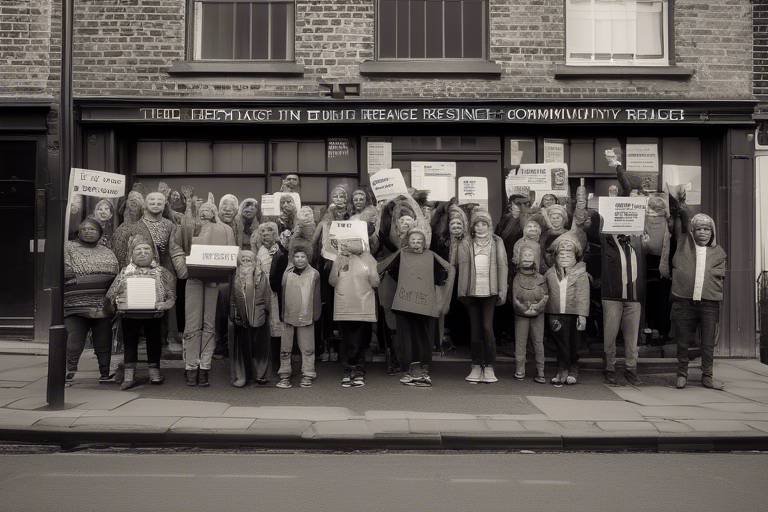Exploring the Impact of Climate Change on Heritage Tourism
Climate change is not just a distant threat looming on the horizon; its effects are already being felt across the globe, including in the realm of heritage tourism. As temperatures rise and weather patterns become more unpredictable, heritage sites are facing unprecedented challenges that threaten their preservation and visitor experience.
One of the key trends in climate change is the increase in extreme weather events, such as hurricanes, floods, and wildfires. These events pose a significant risk to heritage sites, causing damage to historic buildings, artifacts, and landscapes. The vulnerability of these sites is further exacerbated by rising sea levels, putting coastal heritage sites at particular risk of destruction.
Preserving cultural heritage in the face of climate change impacts is a complex and urgent task. The very essence of these sites, their historical significance and beauty, is at stake. Efforts to protect and conserve these treasures must be intensified to ensure they can be enjoyed by future generations.
As climate change alters the landscape of heritage tourism sites, visitors are witnessing dramatic transformations. From receding glaciers to eroding coastlines, the physical changes in these landscapes serve as a stark reminder of the urgent need for action to mitigate the effects of climate change.
Local communities play a crucial role in adapting to climate change and safeguarding heritage sites. By implementing sustainable practices and community-led initiatives, these communities are actively contributing to the resilience of heritage tourism in the face of environmental challenges.
Government policies also play a significant role in addressing the impact of climate change on heritage tourism. Through regulations, funding, and strategic planning, governments can support the preservation and sustainable development of heritage sites, ensuring their protection for future generations.
International collaboration is essential in protecting heritage sites from climate change threats. By sharing knowledge, resources, and best practices on a global scale, countries can work together to safeguard these irreplaceable treasures and promote sustainable tourism practices.

Climate Change Trends
Climate change trends are becoming increasingly evident in the world today, with rising temperatures, erratic weather patterns, and melting ice caps. These changes are not only impacting the environment but also posing significant challenges to heritage tourism sites globally. As temperatures continue to rise, coastal heritage sites are particularly vulnerable to the threat of rising sea levels, leading to erosion and potential submergence of valuable historical landmarks. Extreme weather events, such as hurricanes and wildfires, are also on the rise, posing a direct risk to the preservation of cultural heritage.

Heritage Sites Vulnerability
Heritage sites around the world are facing increasing vulnerability due to the impacts of climate change. The rising sea levels pose a significant threat to coastal heritage sites, putting iconic landmarks and historical buildings at risk of erosion and submersion. Extreme weather events, such as hurricanes and wildfires, are also becoming more frequent and intense, endangering the structural integrity of heritage sites and disrupting their ecosystems.
Furthermore, the delicate balance of ecosystems within and around heritage sites is being disrupted by climate change, leading to the loss of biodiversity and affecting the overall resilience of these areas. The cultural significance and historical value of these sites are at stake as they struggle to withstand the changing environmental conditions brought about by climate change.
Heritage sites that rely on specific climatic conditions or natural features for their preservation are particularly vulnerable to the alterations caused by global warming. The gradual shifts in temperature, precipitation patterns, and seasonal changes can have profound effects on the authenticity and integrity of these sites, challenging their long-term sustainability.

Cultural Heritage Preservation
Preserving cultural heritage in the face of climate change poses significant challenges that require innovative solutions and collaborative efforts. As the impacts of climate change intensify, heritage sites around the world are increasingly vulnerable to degradation and loss. The rich tapestry of history and tradition woven into these sites is at risk of being eroded by rising sea levels, extreme weather events, and other environmental stressors.
Efforts to safeguard cultural heritage from the ravages of climate change involve a multi-faceted approach that combines traditional conservation techniques with modern technologies. Conservationists and experts are working tirelessly to develop adaptive strategies that can mitigate the effects of climate change on heritage sites. This includes implementing measures to prevent erosion, combatting moisture damage, and protecting architectural structures from weather-related deterioration.
Furthermore, raising awareness about the importance of cultural heritage preservation in the context of climate change is crucial. Education and advocacy play a key role in fostering a sense of responsibility and stewardship towards our shared heritage. By engaging local communities, policymakers, and visitors in conversations about the significance of heritage sites, we can inspire collective action to protect and conserve these invaluable treasures for future generations.
Incorporating sustainable practices into the management and maintenance of heritage sites is another essential aspect of cultural heritage preservation in the era of climate change. Implementing eco-friendly initiatives such as renewable energy sources, water conservation measures, and waste reduction strategies can help reduce the carbon footprint of heritage tourism activities and contribute to the overall resilience of these sites.
Collaboration between stakeholders at the local, national, and international levels is paramount in ensuring the long-term preservation of cultural heritage in the face of climate change. By fostering partnerships between governments, non-profit organizations, academia, and the private sector, we can leverage collective expertise and resources to develop comprehensive strategies for safeguarding heritage sites from environmental threats.

Visitor Experience
When it comes to heritage tourism, the visitor experience plays a crucial role in shaping how individuals connect with the historical and cultural significance of a site. With the impacts of climate change becoming more evident, visitors are witnessing firsthand how these environmental shifts are altering the landscapes and narratives of heritage sites. Imagine standing in front of a centuries-old monument only to realize that its structural integrity is at risk due to rising sea levels or extreme weather patterns. The emotional and educational journey that visitors embark on is now intertwined with the urgent need to address climate change and its effects on these cherished destinations.
As visitors navigate through heritage tourism sites, they are not only seeking to admire the beauty and history of these locations but also to understand the intricate relationship between human heritage and the natural environment. Climate change is reshaping this dynamic, prompting visitors to question the sustainability of these sites and the long-term implications of environmental degradation. The once static and timeless experience of heritage tourism is now infused with a sense of urgency and responsibility towards preserving these cultural treasures for future generations.
Furthermore, the changing landscapes of heritage sites due to climate change effects are offering visitors a unique opportunity to witness the adaptability and resilience of these historical landmarks. The juxtaposition of ancient architecture against a backdrop of environmental transformation serves as a powerful reminder of the interconnectedness between past, present, and future. Visitors are not just passive observers but active participants in the evolving narrative of heritage tourism, where each footstep contributes to the collective effort of safeguarding these sites from the ravages of climate change.

Changing Landscape
When it comes to heritage tourism sites, the impact of climate change is not just limited to the atmosphere. The changing landscape due to climate change effects has been a significant concern for these historical and cultural treasures. Imagine visiting a heritage site only to find that the once lush greenery has turned into a barren land, or the iconic structures are now at risk of erosion due to rising sea levels. These visual transformations not only alter the aesthetic appeal of the sites but also pose a threat to their structural integrity.
Climate change-induced alterations in the landscape of heritage sites are not just about the physical appearance but also about the ecosystem that surrounds them. The delicate balance of flora and fauna that has existed for centuries is now under threat as temperatures rise and weather patterns become more erratic. This disruption in the natural environment can lead to a domino effect, impacting the biodiversity and overall ecosystem health of these sites.
Moreover, the changing landscape of heritage sites also affects the way visitors perceive and engage with these historical marvels. The picturesque views that once captivated tourists may now be marred by the signs of environmental degradation. As visitors witness firsthand the impact of climate change on these sites, it raises awareness and prompts discussions on the urgent need for conservation and sustainable practices.
Local communities living in and around heritage sites are also deeply impacted by the changing landscape. Their livelihoods, often dependent on tourism, are at risk as the natural beauty and historical significance of these sites diminish due to climate change. Community adaptation becomes crucial in preserving the heritage and ensuring the economic sustainability of these areas.
In response to the changing landscape of heritage sites, conservation efforts and sustainable initiatives are being implemented to mitigate the effects of climate change. From reforestation projects to eco-friendly infrastructure development, various strategies are being employed to restore and protect the landscapes of these valuable cultural assets. It is through these proactive measures that we can strive to maintain the essence and beauty of heritage tourism sites for future generations to enjoy.

Community Adaptation
In the face of climate change challenges impacting heritage tourism, local communities play a crucial role in adapting and preserving these valuable sites for future generations. These communities often face the direct consequences of climate change, such as extreme weather events and sea-level rise, which threaten the very existence of heritage sites. To combat these threats, communities are implementing innovative sustainable practices to minimize the impact of climate change. By integrating environmentally friendly initiatives, such as renewable energy sources and water conservation measures, communities aim to reduce their carbon footprint and protect the cultural and historical significance of these sites.
Furthermore, community adaptation involves fostering collaborative partnerships with various stakeholders, including government agencies, non-profit organizations, and local businesses. Through community engagement programs and educational initiatives, residents are empowered to take ownership of heritage conservation efforts. By raising awareness about the importance of preserving these sites, communities can mobilize support and resources to implement adaptation strategies effectively.
Moreover, community adaptation extends beyond environmental measures to include social and economic resilience strategies. Local residents are encouraged to diversify their livelihoods and develop alternative income sources that are less dependent on heritage tourism. This approach not only ensures the sustainability of communities but also enhances their resilience in the face of changing climate conditions.
Through community-based initiatives and grassroots movements, residents are actively involved in decision-making processes that impact the conservation and management of heritage sites. By fostering a sense of ownership and responsibility among community members, adaptation efforts become more inclusive and effective. Ultimately, community adaptation serves as a critical component in safeguarding heritage tourism sites and ensuring their long-term sustainability in the midst of climate change challenges.

Sustainable Practices
When it comes to preserving heritage sites in the face of climate change, implementing sustainable practices is crucial. These practices not only help in mitigating the impact of climate change but also ensure the long-term conservation of these valuable sites. One of the key sustainable practices is the promotion of eco-friendly tourism activities that minimize the carbon footprint and reduce environmental degradation.
Additionally, the use of renewable energy sources such as solar and wind power can significantly reduce the reliance on fossil fuels and decrease greenhouse gas emissions. Implementing efficient waste management systems is another sustainable practice that can help in maintaining the cleanliness and ecological balance of heritage sites.
Furthermore, incorporating green infrastructure and sustainable building techniques can aid in the adaptation of heritage sites to changing climatic conditions. By using materials that are environmentally friendly and resilient to climate change impacts, the structural integrity of these sites can be better preserved.

Government Policies
Government policies play a crucial role in addressing the challenges posed by climate change to the heritage tourism industry. These policies are essential for creating a framework that guides the conservation and sustainable management of heritage sites in the face of environmental threats. Governments around the world are increasingly recognizing the need to implement measures that safeguard cultural and natural heritage from the impacts of climate change.
One key aspect of government policies is the establishment of regulations and guidelines that govern the development and operation of heritage tourism sites. These regulations aim to ensure that heritage sites are managed in a way that minimizes their vulnerability to climate change-related risks. By setting standards for construction, conservation, and visitor management, governments can help protect these sites for future generations.
In addition to regulations, government policies also focus on promoting sustainable practices within the heritage tourism industry. This includes incentivizing the adoption of eco-friendly technologies, promoting energy efficiency, and encouraging the use of renewable resources. By supporting sustainable practices, governments can reduce the carbon footprint of heritage tourism activities and mitigate the industry's contribution to climate change.
Furthermore, government policies often include financial support mechanisms to assist heritage site managers in implementing climate change adaptation strategies. This can involve providing funding for infrastructure upgrades, restoration projects, and capacity-building initiatives aimed at enhancing the resilience of heritage sites. By investing in these measures, governments can help ensure the long-term sustainability of heritage tourism in the face of changing environmental conditions.
Moreover, government policies also play a role in raising awareness about the importance of preserving heritage sites in the context of climate change. Through education campaigns, outreach programs, and public engagement initiatives, governments can foster a sense of stewardship and responsibility towards cultural and natural heritage. By engaging with local communities, stakeholders, and visitors, governments can build support for conservation efforts and promote a culture of sustainability.

International Collaboration
International collaboration plays a crucial role in safeguarding heritage sites from the impacts of climate change. By fostering partnerships between countries, organizations, and communities, a united front can be formed to address the challenges posed by climate change on heritage tourism. Sharing best practices, knowledge, and resources on a global scale can enhance the resilience of heritage sites and promote sustainable development.
Frequently Asked Questions
- What are the main impacts of climate change on heritage tourism?
Climate change can have various impacts on heritage tourism, including increased risks to the preservation of cultural sites, changes in visitor experiences due to altered landscapes, and challenges for local communities in adapting to climate-related threats.
- How are heritage sites vulnerable to climate change?
Heritage sites are vulnerable to climate change through factors such as rising sea levels, extreme weather events, and erosion. These threats can endanger the physical structures and cultural significance of these sites.
- What can be done to preserve cultural heritage in the face of climate change?
Efforts to preserve cultural heritage in the face of climate change include implementing sustainable practices, utilizing innovative technologies for conservation, and fostering international collaboration to protect these sites for future generations.
- How can local communities adapt to climate change and its impact on heritage tourism?
Local communities can adapt to climate change by promoting sustainable practices, developing resilience strategies, engaging in community-based conservation initiatives, and actively participating in decision-making processes related to heritage tourism.
- What role do government policies play in addressing climate change challenges in the heritage tourism industry?
Government policies play a crucial role in addressing climate change challenges in the heritage tourism industry by setting regulations for sustainable practices, providing funding for conservation efforts, and supporting initiatives that promote the resilience of heritage sites.



















